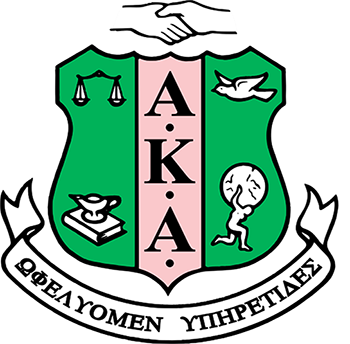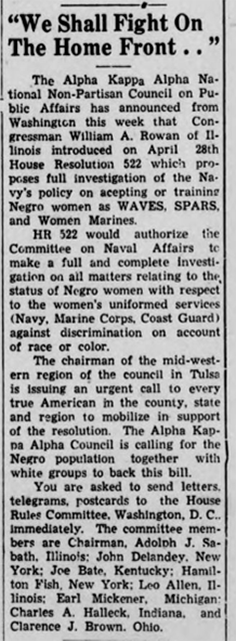
African Americans in Oklahoma Before 1954
Black Greek Letter Organizations
As historically Black colleges and universities and the few integrated institutions of higher education began attracting and graduating Black professionals, students established Black Greek letter organizations (BGLOs). These organizations served important functions throughout the lives of the members. On campus, these groups lent support to students as they attempted to earn both undergraduate and graduate degrees. On the integrated campuses, the BGLOs helped students deal with the isolation of attending a school with very few Black students. Alpha Phi Alpha began in 1906 at Cornell University to help Black students keep working toward their degree instead of leaving school because of the isolation. At historically Black colleges and universities, belonging to a BGLO meant the opportunity to forge a close connection with a group at a large institution. While pursuing degrees, members of BGLOs organized their groups to perform service projects, support members’ academic goals, and host frequent social gatherings.
Once members graduated, they organized alumni versions of their BGLO. In many ways, the groups served functions similar to the Prince Hall Masons, Eastern Star, or the Knights of Pythias. They all organized social activities for members, raised funds for worthy organizations and individuals, and hosted meetings and conferences for members. The major difference between the two types of organization is one of geography. The Prince Hall Masons, Order of the Eastern Star, and the Knights of Pythias were organized locally, and often focused on community needs. The BGLOs rapidly gained a national footprint as alumni moved to new locations for work or family. Members worked to ensure that fellow members knew about distant job opportunities, and provided a network to join once an individual moved to a new place. Each of these organizations worked to end segregation and promote political activity.

Walter Byas’s Kappa Alpha Psi membership certificate, 1939 (Byas Family Collection, OHS).
Kappa Alpha Psi
Kappa Alpha Psi originated at Indiana University in 1911, and an alumni chapter was organized for professionals in central Oklahoma in 1921. This was the first BGLO in Oklahoma. The chapter remained active for five years and then went inactive for a decade. The fraternity organized a chapter on the Langston campus in 1933, and in the 1940s and 1950s, several new chapters organized throughout the state.

Kappa Alpha Psi’s 59th Grand Chapter meeting, photo by Dore Studio (20699.02.197.PR.1, Currie Ballard Collection, OHS).
Alpha Phi Alpha
Alpha Phi Alpha is the oldest Black fraternity in the country. Founded at Cornell University in 1906, Alpha Phi Alpha expanded into an intercollegiate fraternity. The Beta Eta Lambda Chapter of Alpha Phi Alpha organized in 1938, and Dr. Gravelly E. Finley served at the first president. The Alphas conducted service projects involving mentorship and education regularly.

Dr. Gravelly Finley was a charter member of Oklahoma City’s chapter of Alpha Phi Alpha (23427.4, Finley-Slaughter Collection, OHS).
Delta Sigma Theta
The Delta Sigma Theta Sorority began at Howard University in 1913. In 1938, eight women organized the Oklahoma City Alumnae Chapter of Delta Sigma Theta. The first president was Buzeder Ragland and Sareeta Finley served as the first vice-president. Sorority activities were a regular focus in the pages of The Oklahoma Eagle once an alumnae chapter was established in Tulsa. During the 1940s and 1950s, more chapters were added in other towns such as Okmulgee and Langston. Just as the other BGLOs, they organized social events, fundraisers, and scholarships. In Tulsa, the annual scholarship fundraiser was a variety show called the Jabberwock.

This headline in The Oklahoma Eagle announces the 1953 Jabberwock, a charity variety show (The Oklahoma Eagle, February 12, 1953).

Deltas, date unknown (20699.02.197.054, Currie Ballard Collection, OHS).
Alpha Kappa Alpha
The first chapter of Alpha Kappa Alpha (AKA) organized in Tulsa in 1931 when the charter was approved for the Alpha Chi Omega chapter. The graduate Alpha Upsilon Omega chapter also began in 1931 on the Langston University campus. In 1939, the undergraduate Alpha Zeta chapter formed at Langston. These organizations hosted social, community, and educational activities locally. They regularly participated in the Delta Sigma Theta’s Jabberwock variety show. The Tulsa chapter became known for holding a pre-Thanksgiving Vesper Service that hundreds attended yearly. For many years, the women of AKA mentored Tulsa high school students and provided scholarships. Ada Lois Sipuel Fisher was in the sorority, as was Nancy Davis, the first African American female to earn a graduate degree from Oklahoma State University (OSU).

The Alpha Kappa Alpha shield was designed by Phyllis Wheatley Waters in 1920 (image courtesy Alpha Kappa Alpha).

Like other Black Greek letter organizations, Alpha Kappa Alphas advocated for expansion of opportunities for Black Americans (The Oklahoma Eagle, May 20, 1944).

Nancy Davis, far right, at the dedication of a statue on the OSU campus honoring her civil rights work (image courtesy OSU).

